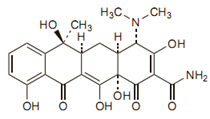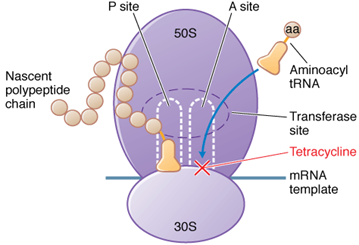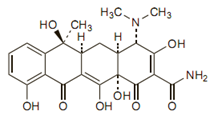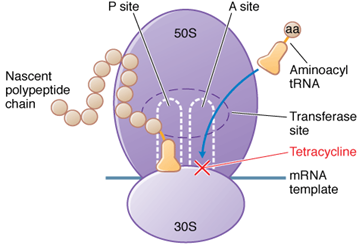 Français
Français Antibiotic Drugs
Tetracycline
Tetracycline is a broad spectrum antibiotic.
Chemical structure
Its chemical formula is C22H24N2O8 and molecular weight is 444.44.The structure is:

Mechanism of action
Tetracycline is a bacteriostatic drug acts by binding reversibly to the 30S subunit of the bacterial ribosome. This inhibits addition of amino acids to the growing peptide resulting in inhibition of protein synthesis.
Site of action

Pharmacokinetics
Absorption of tetracycline may be impaired by ingestion of cations like Ca2+, Mg 2+, Al3+, Fe2+/3+, and Zn2+ by chelating tetracycline and form poorly soluble complexes and by alkaline pH. Tetracycline gets widely distributed in body, so it is useful in wide range of infections.
Antimicrobial spectrum and uses
Tetracycline hydrochloride is among the drugs of choice for the following infections:
- Rickettsial infections - Rocky Mountain spotted fever, typhus fever, Q fever, rickettsial pox and tick fevers.
- Veneral diseases - Lymphogranuloma venereum,chlymadial non-specific urethritis/endocervicitis, Nongonococcal urethritis caused by Ureaplasma urealyticum, Chancroid, and Granuloma inguinale.
- Atypical pneumonia due to M. pneumonia.
- Psittacosis and ornithosis due to Chlamydia psittaci
- Cholera – tetracycline reduces stool volume and duration of diarrhoea.
- Brucellosis, Plague and Relapsing fever.
Previously tetracyclines were used for a variety of common infections, including bacterial gastroenteritis, pneumonia and urinary tract infections. However, numerous strains of bacteria causing these infections now are resistant and other agents have mostly superseded tetracyclines.
Administration and dosage
Dosage
| Condition | Dose | |
| Adults | Children (< 8 years) | |
| Mild to moderate infections | 500 mg bid or 250 mg qid | 25 to 50 mg/kg (4 divided doses) |
| Severe infections | 500 mg qid | 25 to 50 mg/kg (4 divided doses) |
Precautions, contraindications and warnings
Tetracycline should never be used after expiry date. Dairy products, antacids, aluminium hydroxide gels; calcium, magnesium, and iron or zinc salts; bismuth subsalicylate and dietary Fe and Zn supplements can interfere with absorption of tetracycline. Tetracycline is contraindicated in patients with hypersensitivity to any of the tetracyclines, renal impairment, hepatic insufficiency, pregnancy, lactation, children < 8 years of age.
Adverse Effects
Nausea, vomiting, and diarrhea are most common side effects of tetracycline. Other side effects are brown discoloration of the teeth, anorexia, epigastric distress, stomatitis, sore throat, glossitis, black hairy tongue, dysphagia, esophagitis, esophageal ulcers, pancreatitis, liver toxicity, kidney toxicity, photosensitization.
Technical Description on Tetracycline
Tetracycline is a close congener of polycyclic naphthacenecarboxamide. It is a semisynthetic derivative of chlortetracycline which is isolated from Streptomyces aureofaciens. Its chemical formula is C22H24N2O8 and molecular weight is 444.44.The structure is:

Preparations available
Oral: 250, 500 mg capsules; 125 mg/5 mL suspension
Mechanism of Action
Tetracyclines are primarily bacteriostatic. They enter gram negative bacteria by passive diffusion through the porin channels and gram positive bacteria and other organisms by energy-dependent active transport. It is concentrated intracellularly by vulnerable cells. After entering the cell, tetracyclines bind reversibly to the 30S subunit of the bacterial ribosome, blocking the binding of aminoacyl-tRNA to the acceptor site on the mRNA-ribosome complex. This inhibits addition of amino acids to the growing peptide.
The carrier involved in the active transport is absent in the mammalian cells and also tetracyclines do not bind to mammalian 60S or 30S ribosomes. These two factors are responsible for the selective toxicity of tetracyclines to the microbes.
Site of action

Antimicrobial Activity
Tetracycline is bacteriostatic with action against a varied range of aerobic and anaerobic gram-positive and gram-negative bacteria.Tetracycline intrinsically is more active against gram-positive than gram-negative microorganisms, but acquired resistance is common.It is not active against fungi.
Currently tetracyclineis highly efficacious against:
- Mycoplasma pneumoniae, Ureaplasma urealyticum,Actinomyces, Chlymadia pneumonia, C.trachomatis, C.psittaci, Rickettsia, Coxiella burnetii, Legionella species, spirochetes like Borrelia recurrentis, Borrelia burgdorferi (Lyme disease), Treponema pallidum (syphilis), and Treponema pertenue.
It is also effective against:
- Some atypical mycobacteria, some non-tuberculosis strains of mycobacteria (e.g., M. marinum) and Plasmodium species.
It is active against the following gram negative bacteria:
- Haemophilus ducreyi (chancroid), H. influenzae ,Vibrio cholerae and V. vulnificus, Legionella pneumophila, Campylobacter jejuni, Calymmatobacterium granulomatis, Brucella abortus, Helicobacter pylori, Propionobacterium acnes, Burkholderia pseudomallei, Yersinia pestis, Yersinia enterocolitica, Francisella tularensis, and Pasteurella multocida.
- Enterobacteriaceae are now largely resistant.
- Pseudomona aeroginosa, Kleibsella, Proteus, Salmonella, Shigella, Bacteroids fragilis are not inhibited
Following gram positive bacteria are also susceptible:
- Bacillus anthracis and Listeria monocytogens
- Clostridium perfringens and C.tetani
Resistance
Resistance is primarily plasmid mediated and often inducible. Resistance to tetracycline occurs due to any of the3 mechanisms:
(1) Enhanced efflux or diminished influx of tetracycline by an active transport protein pump;
(2) Ribosome protection due to formation of proteins that hinders tetracycline binding to the ribosome; and
(3) Enzymatic inactivation.
Formation of an efflux pump and ribosomal protection are the most significant mechanisms. Gram-negative species expressing Tet(AE) efflux pump and staphylococci expressing Tet (K) efflux pumpare resistant to tetracycline. The Tet(M) ribosomal protection protein expressed by gram-positives produces resistance to tetracycline.Cross-resistance among tetracyclines depends on which mechanism is operative. For example, S. aureus strains that are tetracycline resistant on the basis of efflux mediated by tetK still may be susceptible to minocycline. Tetracycline resistance due to a ribosomal protection mechanism (tetM) yields cross-resistance to doxycycline and minocycline as the target site protected is the same for all tetracyclines.
Pharmacokinetics
Oral absorption is 60–70% for tetracycline and mostly takes place in the stomach and upper small intestine and is more in the fasting state. Absorption may be impaired by alkaline pH and the concurrent ingestion of divalent and trivalent cations (e.g., Ca2+, Mg 2+, Al3+, Fe2+/3+, and Zn2+) as they chelate tetracycline and form poorly soluble complexes. After a single oral dose, the peak plasma concentration is attained in 2-4 hours. The t1/2 is 6-10 hours.
Tetracycline distributes widely into tissues and secretions, including synovial fluid, maxillary sinus, urine and prostate. It accumulates in reticuloendothelial cells of the liver, spleen, and bone marrow, and in bone, dentine, and enamel of unerupted teeth. Concentration in CSF is 10-25 % of those in serum.Tetracyclines cross the placenta to reach the fetus and are also excreted in milk.
The principal route of elimination is the kidney, even though it is concentrated in the liver and excreted in bile. After biliary excretion, it is partially reabsorbed via enterohepatic recirculation. Elimination via the intestinal tract occurs even when given parenterally. Afteroral or IV administration, 20-60% of tetracycline is excreted in the urine within 24 hours.Part of an oral dose of tetracycline remains in the gut lumen, alters intestinal flora, and is excreted in the faeces. Specially buffered tetracycline solutions are formulated for IV use.
Therapeutic Uses
Tetracycline hydrochloride is among the drugs of choice for the following infections:
- Rickettsial infections - Rocky Mountain spotted fever, typhus fever, Q fever, rickettsial pox and tick fevers.
- Veneral diseases - Lymphogranuloma venereum,chlymadial non-specific urethritis/endocervicitis, Nongonococcal urethritis caused by Ureaplasma urealyticum, Chancroid, and Granuloma inguinale.
- Atypical pneumonia due to M. pneumonia.
- Psittacosis and ornithosis due to Chlamydia psittaci
- Cholera – tetracycline reduces stool volume and duration of diarrhoea.
- Brucellosis, Plague and Relapsing fever.
Tetracycline is also useful in:
- Trachoma and Inclusion conjunctivitis caused by Chlamydia trachomatis
- Tularemia due to Francisella tularensis
- Campylobacter fetus infections caused by Campylobacter fetus
- Bartonellosis due to Bartonella bacilliformis
Tetracycline is indicated for treatment of infections caused by the following gram-negative microorganisms, when bacteriologic testing indicates appropriate susceptibility to the drug:
- Escherichia coli
- Enterobacter aerogenes
- Shigella species
- Acinetobacter species
- Haemophilus influenzae
- Klebsiella species
Tetracycline is also indicated for treatment of infections caused by the following gram-positive microorganisms when bacteriologic testing indicated appropriate susceptibility to the drug:
- Streptococcus pneumoniae
- Skin and skin structure infections caused by Staphylococcus aureus.
When penicillin is contraindicated, tetracycline is an alternative drug for the following infections:
- Infections caused by Clostridia species
- Uncomplicated gonorrhea caused by Neisseria gonorrhoeae
- Listeriosis due to Listeria monocytogenes
- Anthrax due to Bacillus anthracis
- Syphilis caused by Treponema pallidum
- Yaws caused by Treponema pertenue
- Vincent’s infection caused by Fusobacterium fusiforme
- Actinomycosis caused by Actinomyces israelii
Other uses:
- In acute intestinal amebiasis, tetracycline may be a useful supportive therapy to amoebicides.
- In severe acne tetracycline may be useful adjunctive therapy.
Previously tetracyclines were used for a variety of common infections, including bacterial gastroenteritis, pneumonia (other than mycoplasmal or chlamydial pneumonia), and urinary tract infections. However, numerous strains of bacteria causing these infections now are resistant and other agents have mostlysuperseded tetracyclines.
Dosage
| Condition | Dose | |
| Adults | Children (< 8 years) | |
| Mild to moderate infections | 500 mg bid or 250 mg qid | 25 to 50 mg/kg (4 divided doses) |
| Severe infections | 500 mg qid | 25 to 50 mg/kg (4 divided doses) |
Drug Interactions
- Dairy products, antacids, aluminium hydroxide gels; calcium, magnesium, and iron or zinc salts; bismuth subsalicylate and dietary Fe and Zn supplements can interfere with absorption of tetracyclines.
- As tetracycline inhibits enterohepatic circulation, concurrent use may render oral contraceptives less effective as they
- Dose of anticoagulants should be reduced as tetracycline canreduce plasma prothrombin activity.
- Concurrent use of tetracycline and methoxyflurane can result in fatal renal toxicity.
- Tetracycline being bacteriostatic may hinder bactericidal action of penicillin; hence avoid giving tetracycline with penicillin.
- It should be avoided with diuretics as blood urea may increase.
- Enzyme inducers like barbiturates, phenytoin and carbamazepine reduce serum levels of tetracycline.
- Tetracycline inhibits intestinal flora that produces vitamin K, and therefore may potentiate the anticoagulant effects of warfarin.
Contraindications
- Hypersensitivity to any of the tetracyclines.
- Renal impairment and hepatic insufficiency.
- Pregnancy and lactation
- Children < 8 years of age.
Precautions
- Intrathecal injections should be avoided.
- Tetracycline should never be used after expiry date.
- Do not mix injectable tetracycline with penicillin – inactivation occurs.
Adverse Effects
Most adverse effects are due to direct toxicity of the drug or to alteration of microbial flora.
Gastrointestinal
- Nausea, vomiting, and diarrhea are most commonly responsible fordiscontinuation of tetracycline.
- Other effects seen are: Anorexia, epigastric distress, stomatitis, sore throat, glossitis, black hairy tongue, dysphagia, esophagitis, esophageal ulcers, and pancreatitis.
- Tetracyclines alter the normal flora, with inhibition of susceptible coliform organisms and overgrowth of pseudomonas, proteus, staphylococci, resistant coliforms, clostridia, and candida.
- This can result in intestinal functional disturbances, anal pruritus, overgrowth of enterococci, Proteus, and Pseudomonas, Moniliasis, thrush, or Candida-associated esophagitis or enterocolitis with shock and death.
Liver Toxicity
- It can impair hepatic function, especially in patients with preexisting hepatic insufficiency, during pregnancy, and when high doses are given intravenously.
- Hepatic necrosis has been reported with daily doses of 4 g or more intravenously.
- Also hepatic necrosis is more common in pregnancy and can be fatal.
Bony Structures and Teeth
- Tetracyclines bound readily to calcium in newly formed bone or teeth in young children.
- It results in permanent brown discoloration of the teeth.
- When a tetracycline is given during pregnancy, it can be deposited in the fetal teeth, leading to fluorescence, discoloration, and enamel dysplasia.
- It can also be deposited in bone, where it may cause deformity or growth inhibition.
Kidney Toxicity
- It is more common with pre-existing renal disease.
- Tetracycline may accumulate to toxic levels in patients with impaired kidney function.
- A reversible Fanconi syndrome like condition is seen with outdated tetracycline due to proximal tubular damage and acidosis caused by degraded products - epitetracycline, anhydrotetracycline and epianhydrotetracycline.
- Fanconi syndrome is characterized by nausea, vomiting, polyuria, polydipsia, proteinuria, acidosis, glycosuria, and aminoaciduria.
Photosensitization
- Systemically administered tetracycline, can induce sensitivity to sunlight or ultraviolet light.
- Onycholysis and pigmentation of the nails may develop with or without accompanying photosensitivity.
Vestibular Reactions
- Dizziness, vertigo, nausea, and vomiting can be seen.
Local tissue toxicity
- IV injection can lead to venous thrombosis.
- IM injection produces painful local irritation and should be avoided.
Other side effects
- Long-term tetracycline therapy may produce leukocytosis, atypical lymphocytes, toxic granulation of granulocytes, and thrombocytopenic purpura.
- It may cause increased intracranial pressure (pseudotumor cerebri) in young infants, even when given in the usual therapeutic doses.
- The pressure quickly returns to normal when therapy is stopped.